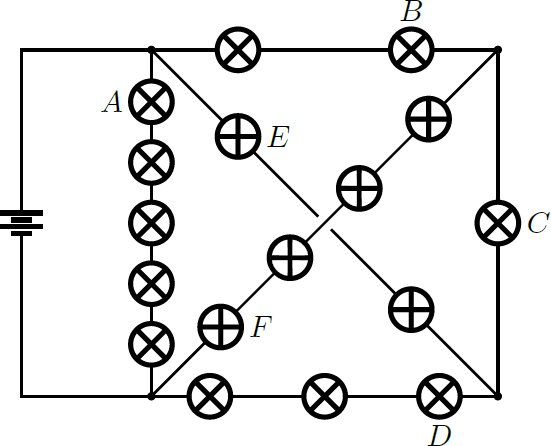Which lamp is the brightest?
Electricity and Magnetism
Level
3
Which lamp is the brightest?

Assumptions: All light bulbs are identical and behave as ohmic resistors.
B
A
E
D
C
F
This section requires Javascript.
You are seeing this because something didn't load right. We suggest you, (a) try
refreshing the page, (b) enabling javascript if it is disabled on your browser and,
finally, (c)
loading the
non-javascript version of this page
. We're sorry about the hassle.
There are four nodes in the circuit, which we label by numbers from 1 to 4. Node 1 and 4 are connected to the battery so that there is a fixed voltage U between them . If we set node 4 to ground, the potentials at the nodes result ⎝ ⎜ ⎜ ⎛ ϕ 1 ϕ 2 ϕ 3 ϕ 4 ⎠ ⎟ ⎟ ⎞ = U ⎝ ⎜ ⎜ ⎛ 1 ξ η 0 ⎠ ⎟ ⎟ ⎞ where ξ , η ∈ [ 0 , 1 ] are unknowns.
All bulbs have the same ohmic resistance R . The resistance R i j = n i j R between two nodes i = j is therefore proportional to the number n i j of light bulbs. The current flowing between the points i and j results according to Ohm's law I i j = R i j ϕ i − ϕ j
For the nodes 2 and 3 the Kirchhoff's current law applies: The sum of all currents emanating from this point must be zero 0 = j = 2 ∑ I 2 j 0 = j = 3 ∑ I 3 j = − I 1 2 + I 2 3 + I 2 4 = − R 1 2 ϕ 1 − ϕ 2 + R 2 3 ϕ 2 − ϕ 3 + R 2 4 ϕ 2 − ϕ 4 = ( − 2 1 − ξ + ( ξ − η ) + 4 ξ ) R U = − I 1 3 − I 2 3 + I 3 4 = − R 1 3 ϕ 1 − ϕ 3 − R 2 3 ϕ 2 − ϕ 3 + R 3 4 ϕ 3 − ϕ 4 = ( − 2 1 − η − ( ξ − η ) + 3 η ) R U This results in a linear system of equations for the unknowns ξ , η . In matrix form the system of equations can be represented and solved as follows ⇒ ( 4 7 − 1 − 1 6 1 1 ) ⋅ ( ξ η ) ( ξ η ) = ( 2 1 2 1 ) = 4 7 ⋅ 6 1 1 − 1 1 ( 6 1 1 1 1 4 7 ) ⋅ ( 2 1 2 1 ) = 5 3 1 ( 3 4 3 3 ) ≈ ( 0 . 6 4 1 5 0 . 6 2 2 6 ) With the help of the potentials ϕ i all currents I i j can now be calculated according to Ohm's law I 1 2 = 2 1 − ξ R U I 1 3 = 2 1 − η R U I 1 4 = 5 1 R U I 2 3 = ( ξ − η ) R U I 2 4 = 4 ξ R U I 3 4 = 3 η R U ≈ 0 . 1 7 9 2 ⋅ R U ≈ 0 . 1 8 8 7 ⋅ R U = 0 . 2 ⋅ R U ≈ 0 . 0 1 8 9 ⋅ R U ≈ 0 . 1 6 0 3 ⋅ R U ≈ 0 . 2 0 7 5 ⋅ R U Thus, the current flow between 3 and 4 is the highest, so that the lamps shine the brightest here. (However, the differences are very small.)